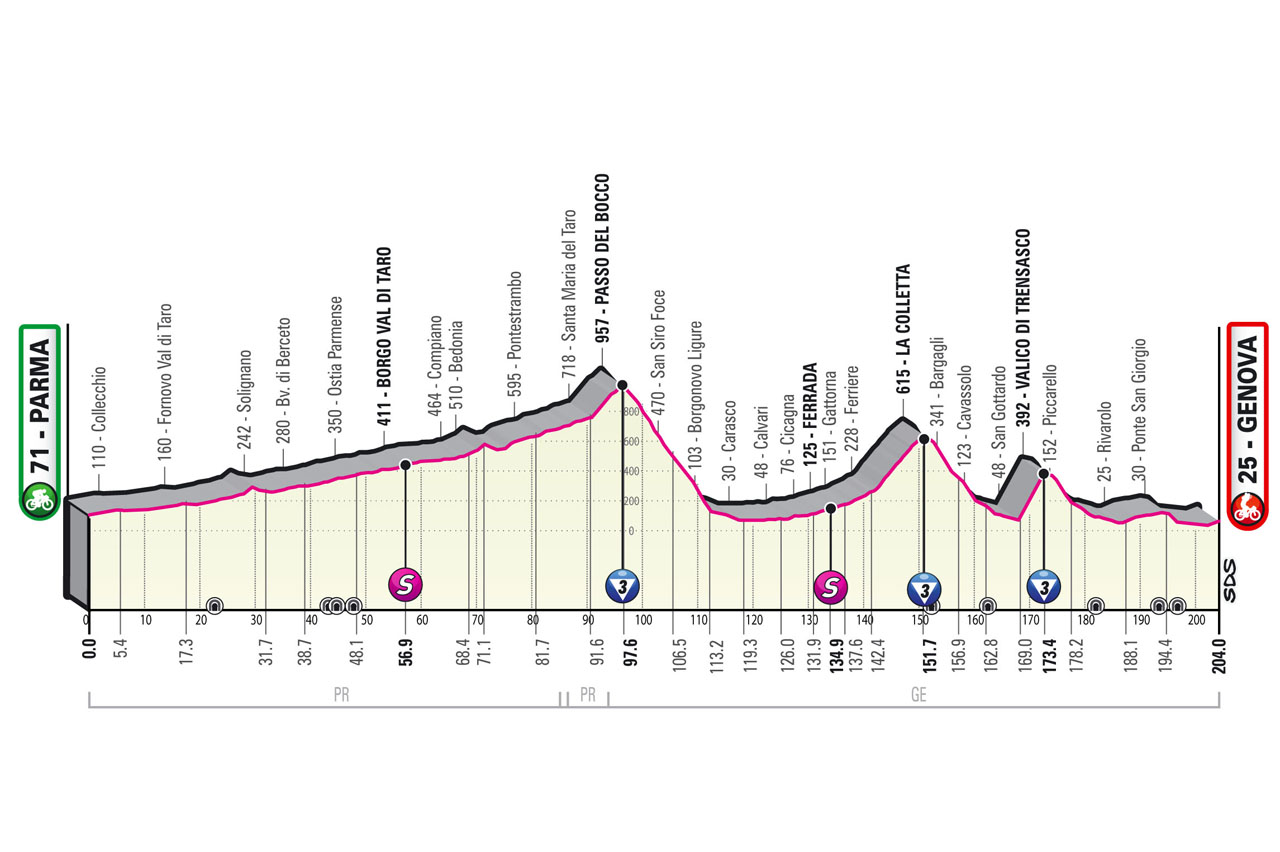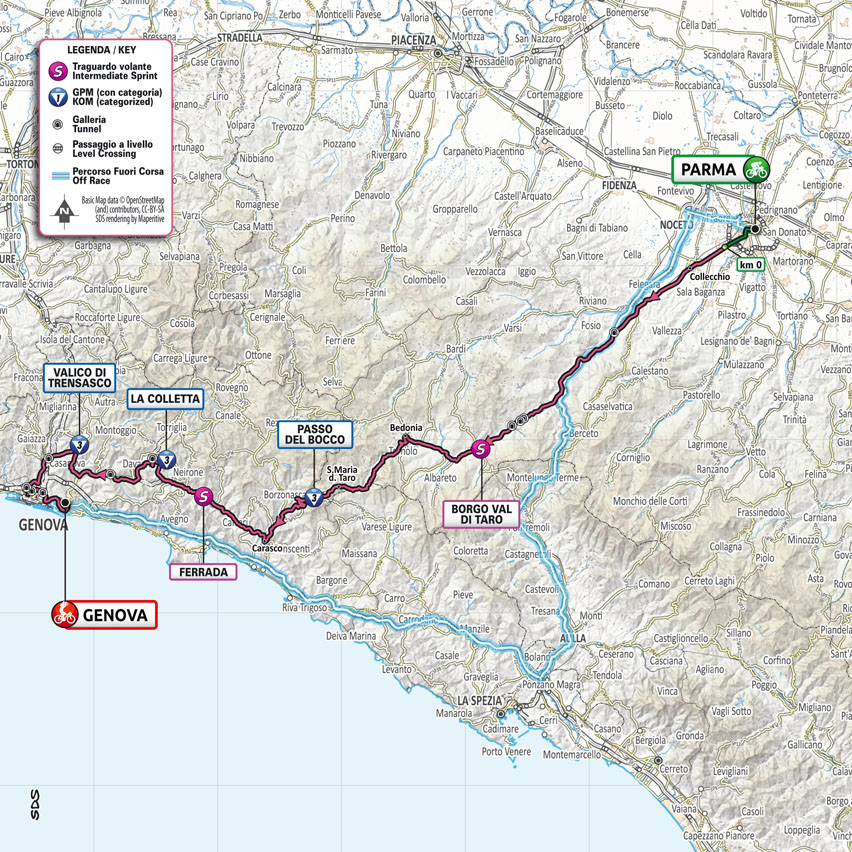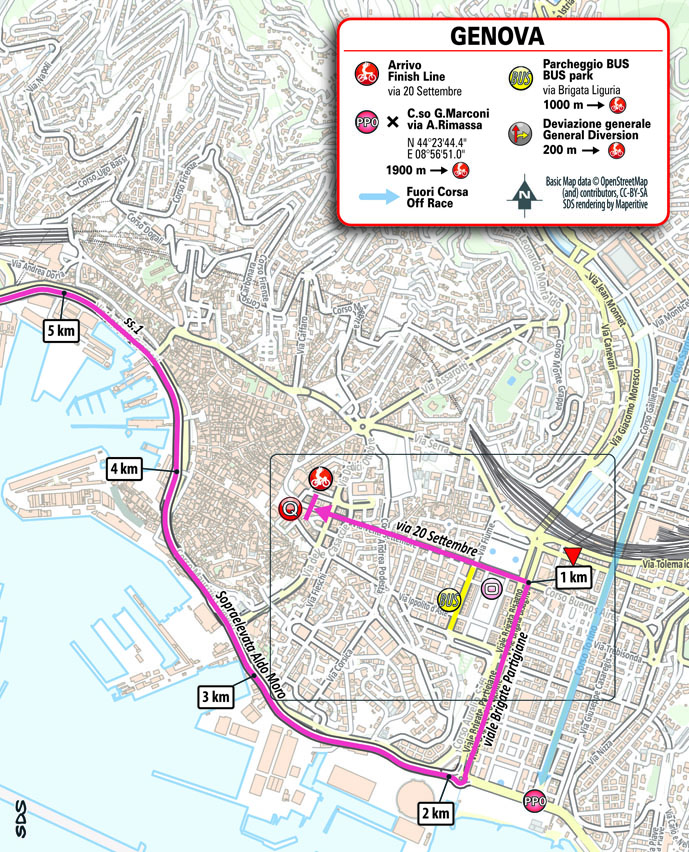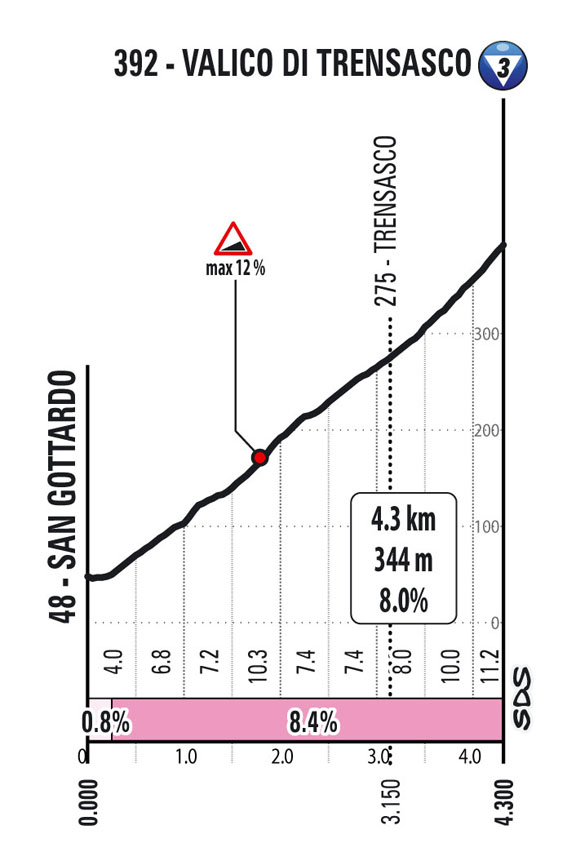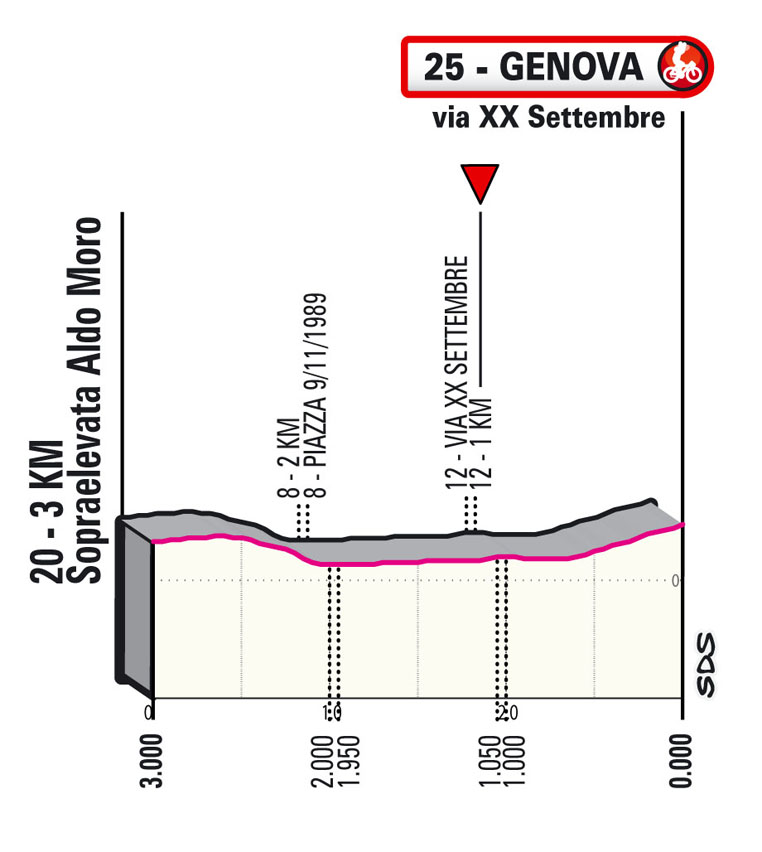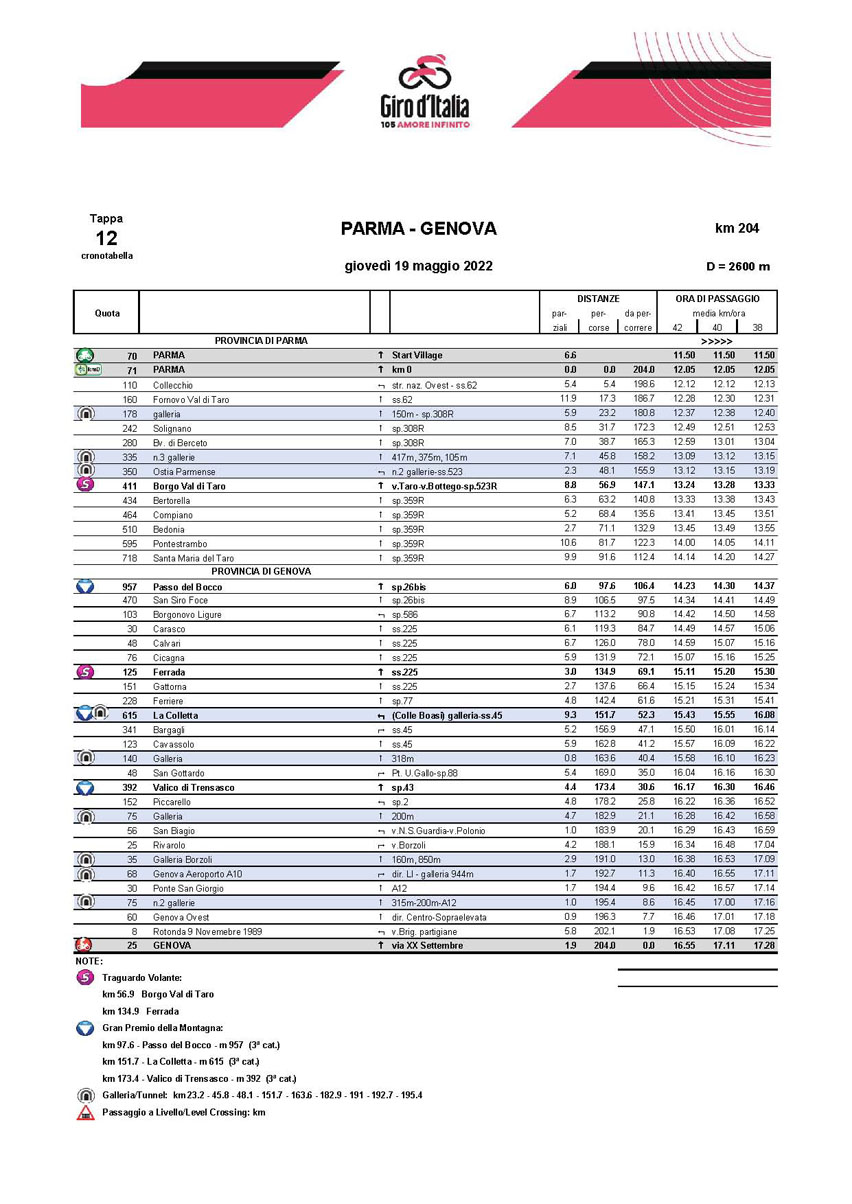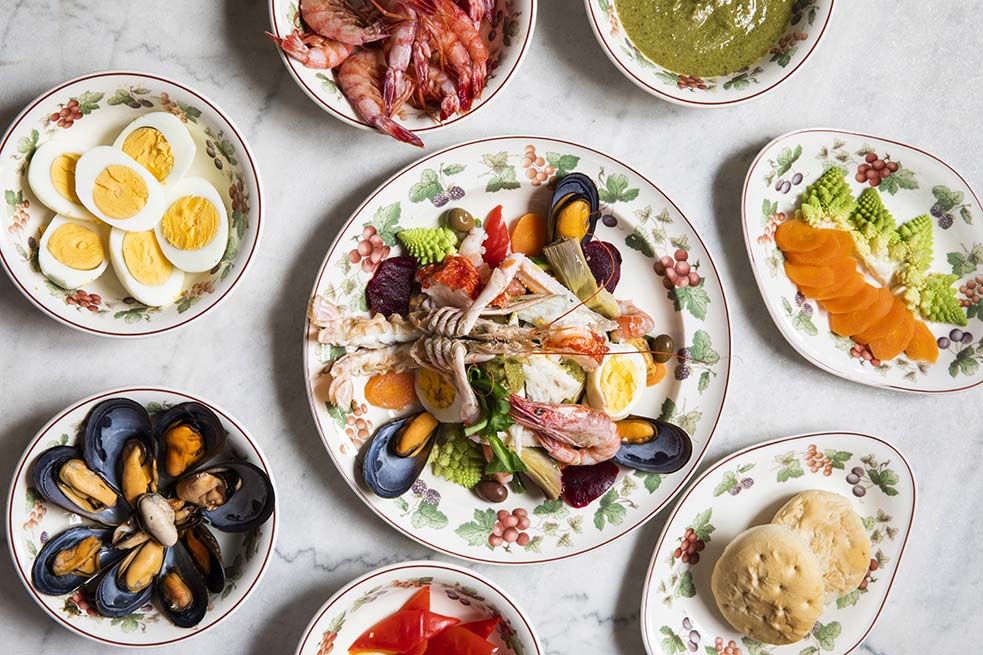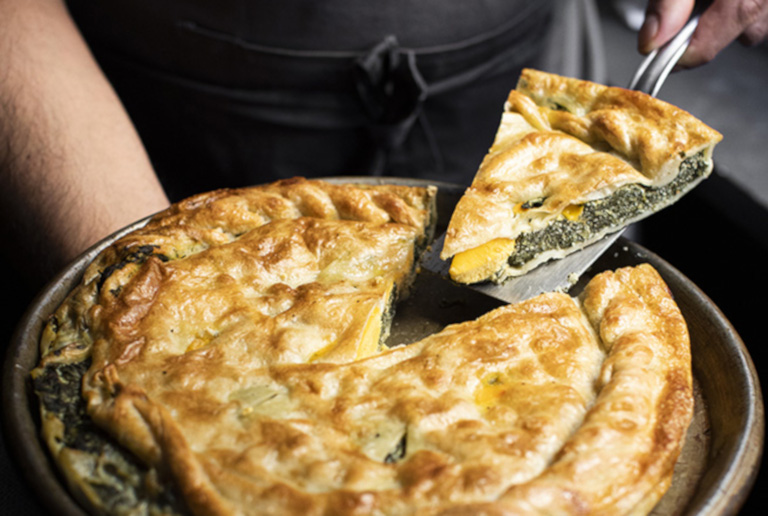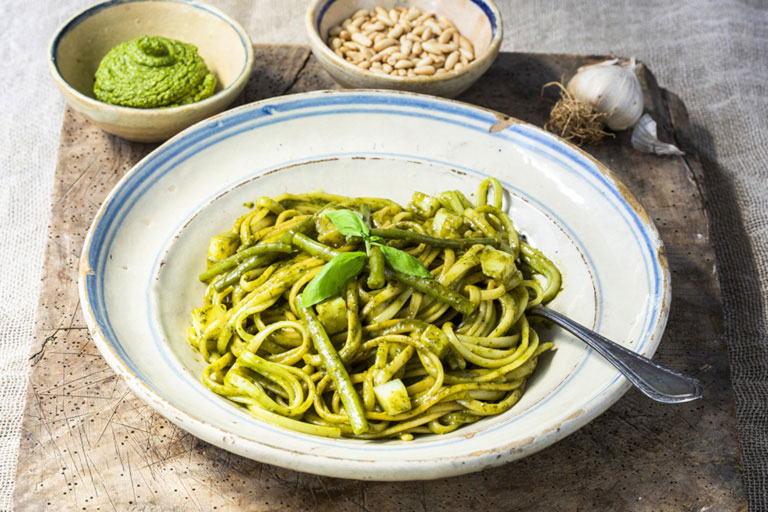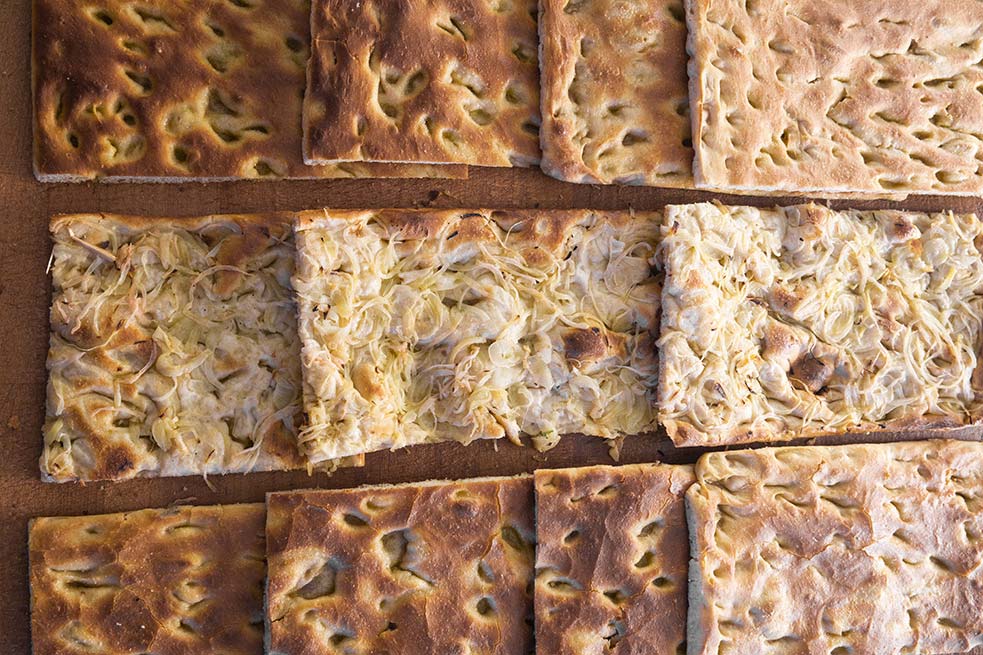profile
map
technical info
The route
A challenging stage across the Apennines. The route ascends steadily with very mild gradients from Parma, along the Taro river valley, entering Liguria through the uncomplicated Passo del Bocco. A long and technical descent follows, leading towards Carasco and into the Val Fontanabuona. The route then tackles the Colletta di Boasi and the Valico di Trensasco. The riders will pass along the motorway and cross the new San Giorgio bridge, heading for the finale in the city centre.
Final kilometres
After taking the motorway, the route crosses the San Giorgio bridge and takes the Genova Ovest exit (passing through a few tunnels), merging onto the Aldo Moro flyover up to the ‑2 km mark. Over the last 2 km, the road is straight, wide and well paved, slightly uphill, and with only one bend at the red triangle. The stage homes in on tarmac road, at approx. 2%.
start / finish
climb detail
final kilometres
itinerary timetable
tourist info
Host city:
Parma
Overview
Parma, also referred to as “la petite capitale” (which translates as “the little capital”), has inherited all of the grandeur of the duchy of Marie Louise of Austria. It was the birthplace of two great masters of opera, Giuseppe Verdi and Arturo Toscanini. It is the capital of the Italian Food Valley and a UNESCO’s Creative City of Gastronomy, for its wealth of DOP and IGP products (protected designation of origin and protected geographical indication, respectively), and for the ability to process and transform these products into culinary masterpieces. It was the Italian Capital of Culture in 2020 and 2021, for its rich museum network and its architectural and artistic legacy. A multitude of definitions that truly captures the many different facets and features of Parma: a small but charming city, where you can dive in the classy atmosphere, and enjoy unique, tailor-made and exciting experiences. After all, as the American poet T.S. Eliot said, “The journey, not the destination matters.”
Food
Parma, the capital of the “Italian Food Valley”, is home to a whopping 12 appellation-protected foodstuffs, including world-renowned protected designations of origin – Culatello di Zibello, Parmigiano Reggiano and Prosciutto di Parma – and protected geographical indications – Coppa di Parma, Salame Felino and Fungo di Borgotaro. As certified by the Ismea-Qualivita Report, Parma is the first province in Italy in terms of economic value generated by DOP and IGP productions. Its territory is a leading producer of pasta, canned tomatoes, dairy and, surprisingly, anchovies: despite not being a seaside territory, in fact, the Parma Food Valley accounts for 70% of Italy’s anchovy production (both salted and in oil). Not coincidentally, Parma was named a UNESCO’s Creative City of Gastronomy in December 2015, being the first Italian territory to receive this recognition.
It is often said that food is culture, and this is even truer in Parma. Here, for a start, you will find a network of seven food museums (Musei del Cibo). ALMA, the world’s leading international educational and training centre for Italian cuisine, is based in nearby Colorno. Parma is also the city of the Gastronomic Library of the Accademia Barilla: a collection of over 14,000 books, 150 old prints and more than 5,000 historical menus. Last, but not least, the University of Parma was Italy’s first-ever to ever launch a public undergraduate program in Gastronomic Sciences.
In order to promote this invaluable heritage of food and culture, the municipality of Parma has founded a club of over 200 tourism service providers, including producers, restaurant owners, accommodation owners, shops and gourmet stores, specialised tour operators and tour guides, called “Parma City of Gastronomy”. This club was founded to leverage the capabilities of the network to spread culture and knowledge, starting from the DOP and IGP products of the Food Valley, and to promote Parma as a favoured destination for foodies worldwide. For further information, please visit www.parmacityofgastronomy.it.
Beverage
Parma is rightfully regarded as Italy’s food capital, as well as a major wine-producing area. The features of the climate and of the territory, as well as the sun exposure, are particularly favourable in the area bounded by the Enza river to the east, and the Stirone river to the west. The vine-clad hills in the valleys of the Parma and Baganza rivers are the home of fine and flavour-packed grape varieties that are made into characterful wines. Major centres include Langhirano (Torrechiara and Casatico), Felino (Barbiano) and Sala Baganza (Maiatico and Boschi di Carrega). The Consorzio volontario per la Tutela dei Vini Colli di Parma (producers’ association), established in 1977, consists of 50 holdings, including vine growers and winemakers. The indigenous “Vini Colli di Parma” received DOC status in 1982. The sparkling Malvasia dei Colli di Parma is the finest produce. The colour is straw yellow, and the taste is intensely aromatic. In its dry, semi-dry or sweet varieties, it pairs perfectly with traditional dishes. The DOP Colli di Parma is also famous for Colli di Parma Rosso, made from Barbera and Bonarda grapes, and Colli di Parma Sauvignon. Lambrusco and Trebbiano are the grown mainly in the lowlands, whereas Barbera and Malvasia grapes are prevalent on the hills. The production protocol issued by the Consorzio also includes wines made from the following varietals: Pinot Nero, Pinot Bianco, Pinot Grigio, Chardonnay, Merlot, Cabernet Franc, Cabernet Sauvignon and Lambrusco Maestri.
Parma is also a distinguished beer city. Its territory (especially the so-called Bassa Parmense) is home to countless craft breweries and micro-breweries, and to the world’s most awarded Italian micro-brewery.
Points of Interest
In April 1816, Marie Louise of Austria, Napoleon’s wife, arrived in the small Duchy of Parma and Piacenza. Her presence profoundly changed the city, leaving a permanent mark. Therefore, if you’re exploring Parma you should definitely start from the sites and venues related to the life of the Duchess, and ideally from the Pilotta. This monumental complex is the home of the National Gallery, which was established by Philip and Ferdinand, Dukes of Parma, and also contains valuable artworks purchased by Marie Louise of Austria. The famous painting of a lady with dishevelled hair, “La Scapigliata”, attributed to Leonardo da Vinci, is the highlight of the collection. The Gallery also houses masterpieces by Correggio, Parmigianino, Tintoretto, Tiepolo, Canaletto and Canova.
When touring the Pilotta complex, make sure you stop by the beautiful Teatro Farnese. Designed by Giovan Battista Alberti and built in 1618 at the behest of Ranuccio I Farnese to celebrate Cosimo II de’ Medici’s visit to Parma, this splendid wooden theatre was an unprecedented architectural masterpiece back then. Almost entirely destroyed during World War II, the theatre was rebuilt in the 1950s, following the original designs.
The nearby Teatro Regio was built at the behest of Marie Louise of Austria, and inaugurated on 13 May 1829, with Bellini’s “La Zaira”. Since then, this majestic opera house has been the home of masters like Giuseppe Verdi and Arturo Toscanini, who were natives of the territory. One of the leading opera festivals in Italy, the Festival Verdi, is held at the Teatro Regio every year in September and October.
Moving on and away from the life of the Duchess, your tour through the cultural and artistic heritage of Parma continues as you reach Piazza Duomo, where you’ll find the beautiful cathedral, which holds invaluable artworks such as Antelami’s “Descent from the Cross”, or Correggio’s “Assumption of the Virgin”, an impressive illusionistic fresco decorating the vault. The Baptistery, built by Benedetto Antelami starting in 1196, is a testimony of the transition from late Romanesque to Gothic architecture. Inside, it holds a stunning cycle of statues depicting the months and seasons, with their corresponding zodiac signs, sculpted by Antelami himself.
Major landmarks also include the Basilica of Santa Maria della Steccata and the Camera della Badessa (the Abbess’s chamber), in the nearby former monastery of San Paolo. The Basilica, with its Greek-cross plan, is a masterpiece of Renaissance architecture. It was built starting in 1521, to provide better protection to the painting of a nursing Madonna, which was worshipped by crowds of pilgrims, and was merely protected by a wooden fence. The Basilica holds valuable artworks by Parmigianino, including a cycle of frescoes depicting the ‘wise virgins’ and the ‘foolish virgins’. The Abbess’s chamber is renowned for its late-Gothic umbrella vault, decorated by Correggio to mimic a pergola made of woody vines. The painting is considered as a masterpiece of Italian Renaissance art.
The Palazzo Ducale, which is considered as the ‘royal palace’ of Parma, attracts artists, visitors and collectors from all around Europe. The Castello dei Burattini (puppet museum), is the major collection of items related to puppetry art, the legacy of the legendary puppeteer Giordano Ferrari. The Pinacoteca Stuard is a collection of archaeological finds, designs, etchings, paintings, sculptures, furniture and gadgets from the late antiquity to the 20th century, named after Giuseppe Stuard, a philanthropist and art collector. The Palazzetto Eucherio Sanvitale is a gem of late-15th century architecture, decorated with frescoes of landscapes and religious figures. All of the above, including the Abbess’s Chamber, belong to the civic museums network of Parma.
For further information, please visit Parma Welcome and Parma 2020.
Genova
Touristic Information
Genoa, a city in Northern Italy and the capital of Liguria, is a unique jewel set between sea and mountains.
The city, well connected to Milan and very close to the Alps, is one of the main ports on the Mediterranean and hides an heritage of beauty to be explored.
The mild climate is perfect for a holiday or a city break to be experienced all year long, among ancient seaside villages, parks, historic buildings of UNESCO heritage, historic shops that preserve the knowledge and the flavours of the past: an authentic cuisine rich of tradition and trekking paths that lead to the discovery of the Genoese fortifications, surrounded by greenery but always with an amazing view over the sea!
Genoa is one of those cities that you don’t expect, that makes those who choose to discover it fall in love and that remains in your heart.
Gastronomy
Genoa is a city worth tasting. Its culinary tradition has ancient roots and reveals the character of the territory and the cleverness of its people who have been able to invent genuine, tasty and attractive cuisine, using simple ingredients.
Walking through the historic centre it’s impossible to resist the temptation of a piece of Genoese focaccia, a real delight for the palate, ideal for a snack at any time of the day!
At lunchtime nothing like stopping in one of the ancient sciamadde (the term comes from “flame” and identifies the ancient street chip shop with wood oven), where you can taste delicious specialties such as farinata, made with chickpea flour and baked in a wood oven, stuffed anchovies, frisceu (tasty salty fritters made with batter) and numerous vegetable pies.
At dinner time, there are many restaurants where you can spend the evening and enjoy the specialties of Genoese cuisine, first of all the pesto, the undisputed king of local food, which here has a unique flavour, also thanks to the Genoese D.O.P. (denomination of controlled origin) basil.
And if after tasting it, you will not be able to do without it, there are many opportunities to attend courses and cooking lessons to learn all the secrets to prepare a pesto like a real Genoese!
Typical Genoese cuisine is also rich in fish dishes, such as cappon magro, a scenic and appetizing fish salad; the stockfish is excellent both “accomodato” (stewed with potatoes, olives and pine nuts) and like a salad, called brandacujun. And then the anchovies, prepared in a thousand different ways!
To end on a sweet note, not to be missed the pànera, a typical coffe-flavored parfait and the Genoese pandolce, a typical Christmas dessert that can be found in the pastry shops all year round!
Beverages
Liguria is a strip of land between the sea and the mountains, with terraces overlooking the sea, perched on the slopes: wine-growing in this area deserves the nickname of “heroic” for the passion and tenacity that requires. Wines are the expression of the area. The most representative wines, Vermentino and Pigato, cannot be missed on the table.
The first one has an intense colour and a delicately soft aroma, an excellent matching with vegetable and fish. Pigato, that blends with first courses, is more strong flavour and fruity. Vermentino is produced throughout Liguria with different emphasys and nuances due to the different soil, while Pigato is mainly produced in the Riviera di Ponente, in Finale, Albenga and in Riviera dei Fiori. For a few years, some winery companies have restart to produce white wines also in the Genoese valleys.
Main sights
Genoa is a city to discover which offers many ideas for visits and itineraries between art, culture, traditions, sea and nature. Here is a “top ten” of the places not to be missed for those who visit the city!
Historic centre
The historic centre of Genoa is a maze of narrow alleys, the caruggi, where it is amazing to get lost with the nose up, among ancient palaces, romanesque and baroque churches, art galleries, charming squares and artisan shops that still preserve the jobs of the past.
To enjoy a 360° view of the historic centre do not miss the liberty lift that leads from the city centre to Spianata Casteletto, a wonderful panoramic terrace where the gaze can space among slate roofs, terraces, towers, domes of the churches until plunging into the blue of the sea.
I Palazzi dei Rolli
In 1576 the Senate of the Republic of Genoa created the lists, the “Rolli degli alloggiamenti pubblici” which include the most prestigious noble palaces of the city. Since it wasn’t possible to host state visits at Palazzo Ducale, both for political and logistical reasons, the owners of the palaces included in the lists were obliged to host state visits in rotation and take charge of all representatives’expenses
The model of public hospitality created in Genoa is unique: thanks to its international guests, such as the famous flemish painter Peter Paul Rubens, who celebrated these palaces in his successful book, published in Antwerp, Genoa became famous all over Europe for the quality of its architectures and for its refined and high level lifestyle. In 2006, the 42 Rolli palaces were included in the UNESCO listings.
Twice a year Genoa celebrates its Palazzi dei Rolli with the Rolli Days, a weekend where some of the 42 palaces open their doors to the public
Museums
Genoa offers a rich and wide-ranging variety of museums, as well as a cultural heritage of the highest quality. Archaeological finds, naturalistic models, extraordinary historical documents and art masterpieces evoke glorious eras and famous historical figures – Colombo, Rubens, Van Dyck, Paganini – which link the events of the modern and contemporary eras.
In Via Garibaldi, you can find the Strada Nuova Museums. All united in a single itinerary, they are part of the historic centre, a UNESCO heritage site: Palazzo Bianco, Palazzo Rosso (currently closed for restaurarion works) and Palazzo Tursi. The grandeur and refinement of the Genoese Baroque residences is also reflected in the Royal Palace Museum (Museo di Palazzo Reale) and the National Gallery of Palazzo Spinola di Pellicceria, where one can admire rich painting collections with portraits of the Genoese aristocracy made by Rubens and Van Dyck among period furniture, silverware, furnishings and tapestries.
Not to be missed a visit to Castello d’Albertis, museum of the culture of the world, which keeps rich etnographic collections in a suggestive neo-gothic castle with a wonderful view on the city; at Galata Sea Museum, the greatest and most innovative maritime museum of the Mediterranean, visitors can discover the deep relation between Genoa and the sea, through interactive settings and reconstructions.
Historic shops
One of the most charming surprises of the historic centre are the historic shops: these are shops and artisans workshops that have been active for at least seventy years. which include pastry shops, clothing shops, butchers, antique shops, grocery stores, trattorias, chocolate shops, wine shops, pharmacies, stationers and much more. Inside these boutiques you can admire frescoed ceilings, stuccoes, shelvings, adorned counters, antique machinery and work tools, and surprising architectural elements.
Parks and Villas
An unexpected Genoa awaits those who decide to leave the coast to venture into the green, among villas and gardens. One of the recommended stops in the western part of the city is Pegli, which can be easily reached by train or by the Navebus service, a boat that operates a regular service from the Porto Antico. In this village you can find the Villa Durazzo Pallavicini: the villa houses the Museum of Ligurian Archaeology. Surrounding it is a perfect example of a romantic garden designed as a theatrical scenic route, with a spectacular avenue of camellias, especially during the flowering period between February and April. Even further west, the beautiful park of Villa Duchessa di Galliera is an equally remarkable location to visit.
On the opposite side, towards the East, you will find Nervi with its villas immersed in parks, among Mediterranean and exotic essences. Here you can admire the Modern Art Gallery in Villa Saluzzo Serra, with 19th and 20th century works, part of art collections donated by the Frugone brothers and kept at Villa Grimaldi Fassio, and the Wolfsoniana, a gallery dedicated to 20th century decorative arts, from Art Nouveau to Deco, from the 20th century to Rationalism.
Villages on the sea
The ancient fishing village of Boccadasse is located not far to the city centre. Here the time seems to have stopped, among the pastel-colored houses and the fishermen boats on the beach.
Moving to the East, you’ll find Nervi, fishing village with its suggestive Anita Garibaldi Promenade, dug into the rocks, that offers breathtaking views among the deep blue of the sea and the bright green of the historic parks.
Acquario di Genova
27.000 square meters, 70 tanks and over 12.000 animals belonging to 600 different species: the Aquarium of Genoa is the largest exhibition of aquatic biodiversity in Europe.
It’s a journey to discover underwater life, among dolphins and sharks, penguins and manatees, jellyfish and seals, tropical fish and Antarctic animals, which will surprise both adults and kids
The Lighthouse
The Lighthouse is the symbol of the city; with itsi 77 meters high, it is the highest lighthouse in the Mediterranean and second in Europe. Inside the monument, you can find the Museum of the Lighthouse, where you can learn the history of this monument. Then, there are 172 steps to climb to get to the first terrace and enjoy a breathtaking view of the city.
Porto Antico
Redesigned by Renzo Piano in 1992 the Porto Antico, the ancient portual area of the city, is nowadays a beautiful square on the sea both for Genoese and tourists.
The area offers many entertaining and leisure occasions, from cinema to restaurants, from ice skating ring to a pleasant aperitif overlooking the sea
Inside the area, in addition to the Aquarium, visitors can find the Bigo, the panoramic lift, whose shape and name recall to the ancient manual loading cranes and the Biosphere, a scenographic sphere of glass and steel, where you can learn about the plant and animal life in tropical forests
The forts and the Parco Urbano delle Mura (Park of the City Walls)
For trekking lovers, Genoa offers many different hikes to discover the ancient genoese fortifications, built between the Eighteenth and the Nineteenth centuries and the Parco Urbano delle Mura, a protected natural area which from 2008 protects 617 hectares of hills between the Bisagno and Polcevera valleys, the two main valleys of Genoa.































